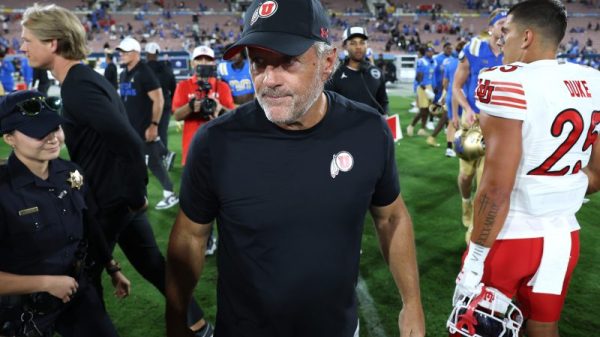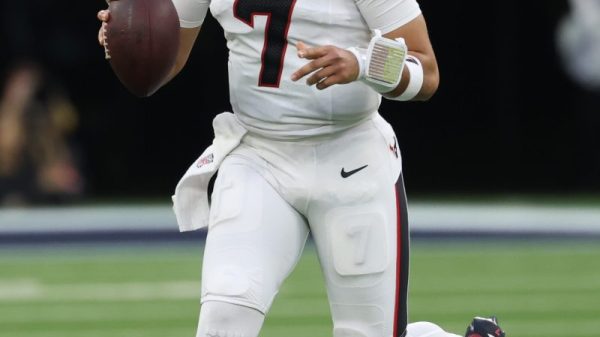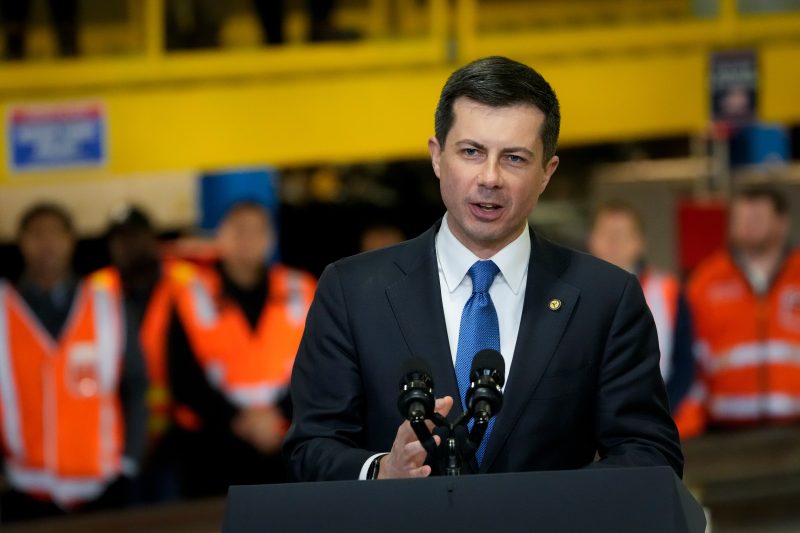“We heard from Sen. Rubio last week, who had some pretty strong words about this incident. I can’t help but notice the last time this agency heard from him on rail regulation was his signature being on a letter that was pretty obviously drafted by industry, calling on us to weaken our practices around track inspection.”
— Transportation Secretary Pete Buttigieg, in an interview with reporters, Feb. 20
“First @SecretaryPete was m.i.a. on the derailment. Then he lies to media claiming my 2021 letter calling for more track inspections was a letter calling for deregulation.”
— Sen. Marco Rubio (R-Fla.), in a tweet, Feb. 21
“The facts don’t lie. The 2021 letter you signed was obviously drafted by railroad industry lobbyists. It supports waivers that would reduce visual track inspections.”
— Buttigieg, in a tweet back at Rubio
The train derailment in East Palestine, Ohio, has become tangled up in politics, with former president and 2024 presidential candidate Donald Trump paying a visit to the site Wednesday and Buttigieg scheduled to arrive there Thursday. Earlier this week, Buttigieg got in a public feud with Rubio — who has called for him to be fired — over whether Rubio wanted to “weaken our practices around track inspection.”
Rubio called Buttigieg a liar. That’s not a word we normally use at The Fact Checker, so it inspired us to take a deep look at this complicated issue.
Train tracks can warp or get out of alignment. For decades, visual inspection of rails — walking on them — was the best way to spot flaws. But in the past 50 years, technology has improved.
Track inspectors now ride in hi-rail vehicles — highway vehicles with conversion kits that let them run along the railroad tracks, too. Increasingly, automated systems, using sensors that measure the position, curvature, alignment and other elements, have augmented the inspections and provided a wealth of data.
“Even if the hi-rail vehicle is moving at 10 to 15 miles per hour, that was too fast for the inspector to pick out anything but the very largest track defects,” said Steve Ditmeyer, who as the Federal Railroad Administration’s director of research and development from 1995 to 2003 advocated for the development of the Automated Track Inspection (ATI) program. “However, the hi-rail vehicle enables the inspector to observe drainage problems, incipient rock slides and other potential obstructions along the right-of-way.”
The automated system “detects and helps remediate approximately 10,000 verifiable track safety defects,” according to the FRA website. “FRA believes ATIP provides a beneficial service and helps railroads reduce the number of geometry caused derailments.”
In a 2021 report to Congress, the Department of Transportation said track-related issues caused one-quarter to one-third of all train accidents from 2001 to 2020, but the number of track-caused derailments have decreased from 4,780 in 1978 to 382 in 2020. “Use of automated track inspection technologies, in addition to visual inspections, has helped drive down the number of track-caused derailments,” the report said.
Now the technology has moved beyond inspection vehicles, which had dedicated crews who operated the equipment, to autonomous systems — which can be mounted to a car or locomotive on a train. Onboard computers churn out reports on track defects or deficiencies, and then any problems are reported to field personnel for repair. This is known as the Autonomous Track Geometry Measurement System (ATGMS).
There is nothing that prevents rail companies from testing and implementing such systems across the country. But as part of a test of these autonomous systems, the Trump administration started to give rail companies permission to reduce the number of manual track inspections required by law in different parts of the country.
“We aren’t against ATI,” said Jeff Joines, national legislative director of the Brotherhood of Maintenance of Way Employes Division (BMWED), a railroad union. “The technology is old. They reframe it to get rid of inspectors.”
BMWED sued the FRA after the Trump administration gave a waiver in 2018 to BNSF Railway, a big freight carrier, in part because the administration had granted it without seeking any public comment. (The 2021 infrastructure law includes language to prevent FRA from doing that again.) But a federal appeals court ruled in 2019 that the suspension of manual track inspections was limited in scope and necessary for BNSF to effectively test the usefulness of unmanned geometry cars.
When the Biden administration took over, it began seeking comment before taking action on company requests. The unions filed comments opposing extending the waivers. In some cases, only one comment was filed — but by an important union such as BMWED.
While some waivers were extended, gradually they were not renewed. Within the industry, there was shock. The FRA has suggested that enough data has been gathered that it can assess the results of the tests and determine the way forward. One waiver, to BNSF until 2026, remains in place, while all other tests expired as of last year.
“The shift by the FRA is due to politics, essentially giving more concern to the labor unions,” said William C. Vantuono, editor in chief of Railway Age, a trade publication. He says the failure to continue the tests undermines safety.
“I disagree with that,” said a senior FRA official, speaking on the condition of anonymity because the issue is in litigation. “There is a safety basis for visual inspections. We need redundancy and an added level of safety.”
Rubio was one of 23 Republican senators who signed a letter on Oct. 29, 2021, to Amit Bose, then FRA deputy administrator, expressing concern that the testing programs were being allowed to expire. (Bose is now administrator.)
The letter said that the “ATI tests have resulted in an over 90 percent reduction in unprotected main track defects per 100 miles tested” and made clear that additional testing would prove key to “facilitating a better understanding of the optimal balance between ATI and visual inspection.” The letter argued that “this tremendous amount of data collected shows that the data-driven fusion of ATI and visual inspections is producing a superior safety outcome, with track employees’ hours being reallocated to verifying and remedying the greater number of defects detected by ATI rather than conducting redundant visual inspections.”
The senators urged the agency “to embrace these opportunities to improve safety through the FRA’s appropriate and timely handling of waiver and test program submissions.”
That’s the letter that Buttigieg claimed to reporters “was pretty obviously drafted by industry, calling on us to weaken our practices around track inspection.” In his tweet, he said the letter “supports waivers that would reduce visual track inspections.”
Marc Scribner, senior transportation policy analyst at the libertarian Reason Foundation, said the line was “technically true but misleading.” The rail companies were seeking to redeploy visual inspections to areas that ATIP could not detect, though he acknowledged that unions may have a legitimate concern about the long-term implications of the technology. One company is developing a program that would use predictive machine learning to identify future track defects.
When the Biden administration refused to let BNSF expand its waiver to other parts of the United States, BNSF filed suit in 2022, saying “FRA’s action is arbitrary, capricious, an abuse of discretion, and otherwise contrary to law.”
Bose, in his response to the letter signed by Rubio, wrote that “FRA recognizes the safety benefits of ATI, which resulted in a significant reduction in unprotected main track geometry defects per 100 miles tested.” But, he said, there is a critical exception: “ATI technologies employed in the test programs are not capable of detecting many structural defects” at rail switches and rail crossings. “By reducing the number of required visual inspections on main track, the test programs highlighted the need to focus human visual inspections to those structural areas.”
Still, Bose noted, “FRA’s analysis of one test program’s data demonstrated that … monthly walking inspections of turnouts, coupled with ATGMS and reduced visual inspection frequency, maintained the overall safety of the track being inspected.”
DOT’s inspector general in 2022 issued a critical audit of FRA’s use of automated inspections to aid track safety oversight, saying its metrics were outdated and that it could “improve program utilization goals and track inspection reporting.” The report said that although rail companies were conducting tests to see if automation was “a viable alternative to the manual visual inspections,” the FRA did not use its own vehicles to “verify the accuracy of railroads’ automated inspection equipment.”
Joines, the union leader, said that FRA data shows that ATI spots only six out of 23 possible defects that can cause train derailments. Ditmeyer said the problem is especially acute at parts of crossing areas known as frogs, where very narrow rails require visual inspection.
The union has also calculated, with the assistance of FRA, that between January 2016 and June 2022, 371 derailments were caused by factors that ATI would not identify, and 320 were caused by defects that ATI would catch. That suggests that automation would prevent some derailments — but also that it would not prevent more than half.
The FRA official said the agency was planning to write a regulation regarding automated tests. He said there was no need to update the 50-year-old visual inspection regulations. “There is a value in them,” he said. “We should be doing visual inspections in every area.”
After the East Palestine accident, DOT issued a statement saying “the removal of human inspections has been a top priority for the rail lobbyists. Recent waiver requests around technology like Automated Track Inspection (ATI) have been framed by industry to set up a false choice between technology and human oversight.”
“There was widespread concern re: FRA’s implementation and testing of ATI. There was and is widespread agreement that ATI can play a critical role in track safety,” said Dan Holler, Rubio’s deputy chief of staff, in an email. “For Secretary Buttigieg’s claim to be true, he would have to demonstrate that signing a letter to the FRA re: ATI implementation — a letter that raises the same concerns his own inspector general echoed — is equivalent to wanting to eliminate visual inspection. There is no evidence to support such a claim.”
Holler said it was up to Buttigieg to prove the letter was written by industry lobbyists.
Asked to provide evidence, a DOT spokesperson noted that some phrases and points in the letter — “tests each foot of track,” “preventative track maintenance,” track inspection regulations are 50 years old — appeared to be similar to those in a fact sheet issued by the Association of American Railroads, an industry trade group. That’s pretty slim evidence for such a charge.
Buttigieg and Rubio, to some extent, are talking past each other. Buttigieg said Rubio wanted to “weaken our practices around track inspection” and “reduce visual track inspections.” Rubio says he wanted “more track inspections” — automated ones. That way, he argued, employees could be deployed better.
Under the waivers granted to rail companies, they were allowed to reduce the legally required number of visual inspections, though in theory that meant, with the same level of personnel, visual inspections could be more focused. But companies rarely keep the same level of employees when they believe automation works more efficiently.
In other words, it’s a matter of opinion: Do you believe unionized workers add safety, or that automation does better than labor? We don’t fact-check opinions, so we will leave this unrated.
(About our rating scale)
Send us facts to check by filling out this form
Sign up for The Fact Checker weekly newsletter
The Fact Checker is a verified signatory to the International Fact-Checking Network code of principles



























